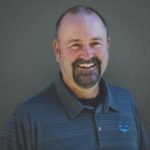
“Plywood earns quality grades at different points in its journey through the mill, ensuring the highest-quality finished product.”.”
From exterior wall sheathing to cabinetry, plywood serves countless uses and is one of the most ubiquitous building materials, especially here in the Pacific Northwest. With so many uses and different types of plywood available, it’s important to know your options, understand the material, and pick the right product for your project.
For our Plywood Series, we’re joined by T.R. Cauthorn, Panel Sales Manager at Hampton Lumber, a leading sustainable lumber producer based in Washington and Oregon and one of Dunn Lumber’s long-standing suppliers. With nearly 30 years spent with Hampton Lumber, plus experience working in mills and forests with Georgia Pacific, T.R. is a plywood expert.
In today’s episode, T.R. explains the different grades of plywood veneer, how grades are assigned, and the steps Hampton Lumber takes to produce the high-quality plywood products you'll find at Dunn Lumber.
From logs to finished product
The plywood grading process begins as soon as logs arrive at the mill. Logs are separated by species first, and secondarily diameter. Group 1 species in the Pacific Northwest are made up of DF (Douglas fir) and a bit of Larch, and Group 2 is hemlock and some coastal spruce and pine.
At the mill, Douglas fir is separated from Hemlock and other wood species due to the moisture content and the drying time required, along with with the strength factor of group 1 species verses group 2. Group 1 is always separated out to make marine-grade or Structural I panels, whereas group 2 species are primarily used as centers, core and back veneers. Keeping the species separated is mandatory throughout the production process.
After separating by species and diameter, the logs are peeled and then move on to the drying process where the mill will strive to dry the veneer to 7-8% moisture content which is ideal for lay up and the rest of the production process. As the veneers leave the dryers they are then graded and separated into different bins to determine where the veneer will go next. Graders are tasked with maximizing recovery, meaning they sort out the highest-grade veneers from the batch, then do the same for the second-highest grade, and so on. The goal of the mill is to upgrade the veneers as much as possible to make the highest grade plywood from the veneer ingredients that they have to work with. The mill does this by trying to upgrade through patching, puttying, or other finish end processes to take a B grade to an A grade or a C grade to a C-plugged grade. In all wood products production, be it plywood mills or sawmills, it is always about the recovery of the finished product from the raw log.
Different grades of plywood veneer
The most common grades are A, B, C, C-plugged and D. When shopping for plywood, you can find grades stamped on each sheet. For example, AC plywood has an A-grade face with a C-grade back.
Other grades or terms you’ll see are CCPTS, Marine-grade or the X which is telling you exterior glue.
- “X” means an exterior glue was used in constructing the plywood sheet (this does not however mean that the plywood can sit out in the weather and not deteriorate).
- C-plugged or Dime C is a slightly higher quality than C-grade and is commonly used for underlayment.
- Marine-grade is plywood created with multiple layers (or plies) of A and B grade veneers. These high grade veneers and through careful layout creates a product without core voids.
- A-grade can have 18 patches or less and typically is the face of the highest grade plywoods
- B-grade can have unlimited patches and runs through the putty line. Used for high grade underlayment products and CCPTS panels. They also make up the core and back of AB marine plywood.
- C-grade typically has 1” knots with occasional 1 1/2 “ knots throughout the plywood. This is the face of all CDX panels.
- D-grade has 1 ½” knots and up and is used for core and back material in CDX and underlayment.
- C-plugged (which is the typical face on underlayment and CCPTS panels) can have tight knots but no dead knots that go unrepaired with either a boat patch or wood dough/epoxy. This panel at some mills is made fully repaired with a B face. Dunn carries a custom made underlayment panel (produce code SF34 with a B face).
Want to learn more about plywood? Be sure to check out how to choose a plywood panel and don't miss this video overview on how plywood is made.


